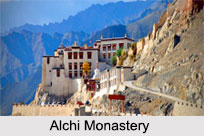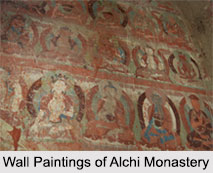 Founded by the famous scholar translator Rinchen Zangpo between 958 to 1055 CE, the Alchi Monastery is a monastic complex located in Ladakh. Unlike the other Buddhist monasteries of Ladakh that are built atop a hill, the Alchi Monastery is unique as it is built on a flat ground. In its initial days, the Alchi Monastery used to belong to the Kadampa school of Tibetan Buddhism though later it was taken over by the Gelugpa order. During the 15th century, religious practises stopped in this monastery and it came under the administration of the Likir Monastery.
Founded by the famous scholar translator Rinchen Zangpo between 958 to 1055 CE, the Alchi Monastery is a monastic complex located in Ladakh. Unlike the other Buddhist monasteries of Ladakh that are built atop a hill, the Alchi Monastery is unique as it is built on a flat ground. In its initial days, the Alchi Monastery used to belong to the Kadampa school of Tibetan Buddhism though later it was taken over by the Gelugpa order. During the 15th century, religious practises stopped in this monastery and it came under the administration of the Likir Monastery.
History of Alchi Monastery
Rinchen Zangpo, the founder of this monastery was also responsible for the creation of several other monasteries during the 10th century, like the Lamayuru Monastery, the Wanla, the Mang-gyu and the Sumda. He also established Buddhist activity in the Ladakh region and other areas like Himachal Pradesh and Sikkim. Zangpo has been credited to build over 108 monasteries, out of which only a few have survived and the Alchi Monastery being one of them.
Geography of Alchi Monastery
The monastic complex of Alchi is located in the village of Alchi but is separate from the other village settlements. The village of Alchi is located at a high altitude of 3,100 metres on the rain shadow area of Ladakh. The village is laid out in four settlements on the south bank of the Indus River and is about 65 km outside of Leh. The flood plain at Alchi is very fertile and provides good and relatively extensive agricultural land. Most of the small houses are made of bricks. The main road at both sides is covered by the apricot trees.
Architecture of Alchi Monastery
Alchi is regarded as one of the most important Buddhist centres in Ladakh and also as the monastic jewels of the region. The paintings on the walls of the monastery show the artistic and spiritual details of both Buddhism and the Hindu kings of that era. These are some of the oldest surviving paintings in Ladakh. The complex also has huge statues of the Buddha and lavish wood carvings and art work which are almost reminiscent of the baroque style. The Alchi Monastery complex has three major shrines, which are listed below.
 The Dukhang: Located at the heart of the monastery, the Dukhang is the assembly hall where monks worship and perform ceremonies. This is known to be Alchi"s oldest structure to have been constructed in the late 11th century by Kaldan Shesrab. It is a large ancient hall with most of its additions being made during the 12th and 13th centuries. There are frescoes of 1000 Buddhas that are depicted in the passageway and the colonnaded veranda leads to the hall from a front courtyard. The walls of the Dukhang is dedicated to Panch Tathagata and are painted with six different mandalas that surround the Vairochana, who is the main deity worshipped in the hall. The mandalas are set among by many paintings of Buddhas, Bodhisattvas, goddesses, fierce divinities and guardians of dharma, and also lesser divinities. On the outer gates of the hall the symbols of the Wheel of Life and Mahakal is present.
The Dukhang: Located at the heart of the monastery, the Dukhang is the assembly hall where monks worship and perform ceremonies. This is known to be Alchi"s oldest structure to have been constructed in the late 11th century by Kaldan Shesrab. It is a large ancient hall with most of its additions being made during the 12th and 13th centuries. There are frescoes of 1000 Buddhas that are depicted in the passageway and the colonnaded veranda leads to the hall from a front courtyard. The walls of the Dukhang is dedicated to Panch Tathagata and are painted with six different mandalas that surround the Vairochana, who is the main deity worshipped in the hall. The mandalas are set among by many paintings of Buddhas, Bodhisattvas, goddesses, fierce divinities and guardians of dharma, and also lesser divinities. On the outer gates of the hall the symbols of the Wheel of Life and Mahakal is present.
The Sumtsek: In the Tibetan architecture, a sumtsek is a small three storied building built with loam and natural stone, which is reflected in the bland exterior. The AlchiS umtsek in the Alchi complex is the most outstanding, but its purpose is not clearly stated. The luxuriant woodwork columns, facades, walls, clay images and paintings in the interior of the monastery were made by Kashmiri artists. The niches depict the main images of three Bodhisattvas, all in standing posture with 2 flying goddesses in each niche. Surrounded by a swirling mass of Mandalas, Buddhas, demi Gods and sundry other celestial, a colossal statue of Maitreya the Buddha-to-come fills a niche on the ground floor. The head of the Lord is shielded from sight, high in the second storey. Accompanying him are two equally grand Bodhisattvas, their heads peering serenely down through gaps in the ceiling. Each of these stucco statues wears a figure clinging dhoti, adorned with different, meticulously detailed motifs. Avalokitesvara, the Bodhisattva of compassion, has pilgrimage sites, court vignettes, palaces and pre-Muslim style Stupas on his robe, while that of Maitreya is decorated with episodes from the life of Gautama Buddha.
The Manjushri Temple: This temple dating back to 1225 AD is built around the four central images of Manjushri, seated back to back. The 4 pillars supported with cross bracing connected to the painted wood ceiling form the enclosure of the images. Each of the four images is single-headed with four arms that are adorned with a sword, a book on top of a lotus, a bow and an arrow. Each wall in the shrine is dedicated to a Buddha image. Manjushri is depicted on the main wall, seated on a lion throne; the side walls have images of Amitabha on the right and Aksharabhya on the left. In the base of the throne on which the Manjushri image is deified is a depiction of `Seven Jewels` and `Eight Suspicious Symbols`, which is flanked by lions, enclosed in a square frame that is distinctive. The top of the throne frame has makara surroundings.
The Chortens: The Chortens are decorated gateways known locally as Kakani Chorten that are considered unique to Alchi with historical link to other monuments. More Chortens were added between the 13th and 14th centuries. In the Alchi complex, there are also three other Chortens, which have ancient paintings.
Visiting Information on Alchi Monastery
The railway stations at Dehradun and Chandigarh are the nearest stations from Alchi. The Leh Kushok Bakula Rinpoche Airport in Leh is the closest at a mere distance of about 64 km.



















